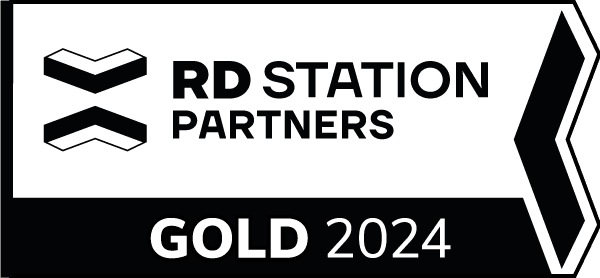Who should lead the company’s digital agenda and strategy?
Many CEOs and corporate leadership teams see the digital opportunity as a focus to impact revenue. In other words, the main objective is to sell products and services (already existing or new) through digital channels, such as the company’s website or mobile app. So, what is the main point to be considered for someone to lead this process?
It’s an interesting question as this is a transitional period where, for example, digital marketing and traditional marketing, digital sales and traditional sales, or digital operations and traditional operations become one process.
Unfortunately, many CEOs or CIOs don’t have customer contact responsibilities. This puts them at a disadvantage if they are responsible for leading opportunities that should benefit the people responsible for the company’s revenue: the customers.
What operational aspects are necessary for this to happen?
To advance digital resources, you need:
- Organizing and managing change to facilitate the speed and flexibility required in digital growth and development
- Digital processes, which are the means by which we use the digital resources with which the customer interacts
- Functional processes that drive and support day-to-day business operations and revenue generation
- Architecture and tools that include the governance infrastructure and applications responsible for collecting and maintaining the data used in digital initiatives


The ideal profile to lead the digital transformation
Executives with internal and external responsibilities: these are the ideal candidates to lead this challenge.
And, in that position, we can include chief information officers (CIOs) or chief technology officers (CTOs), who naturally have an internal operational competency, as long as they have customer-centric responsibilities.
In addition, they can be sales or marketing leaders, who have operational roles as they progress through the corporate hierarchy. They may also be former management consultants, most of whom had sales responsibilities as well as delivery responsibilities.
What about the title of this digital leader?
If the leader taking responsibility for digital transformation is an existing executive, it may not be necessary to give him the title of digital director.
However, some companies find it useful to add this title to the responsibilities to highlight the importance of the work to come and the extent to which it will represent the new sets of activities.
Of course, as we are going through a process of change, as the first waves of transformation are actually introduced, the title may not be necessary, but having someone responsible for change in the early stages can help ensure that the change is managed more effective. After all, the most important thing is that this professional has good leadership skills to implement the process.
The digital revolution has arrived, and while it may seem that the pace of change is going too fast, we can say that the speed is only going to increase. But remember that such speed translates into big opportunities, and there is no greater motivator than that.
If you need help starting the process of digital transformation in your company, contact us!


What are the skills needed to implement digital transformation?
As your company moves towards digital transformation, what skills will be expanded, what new skills will need to be hired or trained?
These are important questions, as the pace and, ultimately, success of this transformation will be only as good as the team you build.
See how to increase the retention of talent in your company
The skills needed will need to combine business skill and technical knowledge.
Agile development
Digital transformation requires agile development that focuses on developing projects iteratively. This contrasts with the traditional cascading method, which is serial in nature, with transfers along the way.
Agile coaches are key new roles in this paradigm. They are part change manager, consultant, and coach.
For example, to ensure the organization has the right skills associated with Agile development, Capital One has developed an Agile Maturity Assessment to train teams to understand where they are on their journey. Once a quarter, company employees are asked to anonymously react to statements in five areas: sustainability, value delivery, Scaled Agile, culture and technical health.
Areas with low scores are flagged for improvement in the next six development cycles or sprints.
Agile coaches then formulate an Agile transformation path for each value stream.
Scrum master
Scrum is a framework associated with agile development that emphasizes frequent meetings of the entire team to map the next phase of development, progress on the chart, correct course, and test results.
Scrum masters are the Scrum leaders and therefore manage the process of how information is exchanged. They also have in-depth technical knowledge.
For example, to facilitate learning, Capital One has established peer groups for Scrum masters with the idea of creating communities where they can share best practices and learn from each other.
Product owner
The third skill needed to incorporate into your teams is product ownership. In the digital age, one must think of the company’s traditional projects or services as products.
The product owner is ultimately responsible for the product being developed. It defines the product vision, charts the development path, tracks progress, and ensures it is delivered.
Agile trainers and scrum masters work on multiple products, but product owners develop a deeper experience in a particular product area.
User Experience Designer (UX Designer)
User experience encompasses the customer experience and the employee experience, depending on who a particular product or project is aimed at.
User experience designers, also called UX Designers, are technical experts, but they can also work with customers individually and through group surveys. They should be familiar with identifying and mapping experiences for different personas, who represent different types of customers or employees, noting the different needs of each and taking them accordingly.
They must also map customer journeys, analyzing each customer or employee interaction with the product to identify what to amplify, what to turn off, and what new ideas might emerge.
A common theme here is that each of these new roles combines several disciplines.
In short, these leaders have traditional business knowledge combined with technical acumen. This means that many are still in development, therefore professionals with these skills are still scarce and can be an expensive acquisition. Therefore, a process needs to be initiated to develop and train these skills among current employees so that this will ensure that you have a growing supply of talent in these critical areas.
With these skills in place, your digital transformation aspirations are much more likely to come true.
Discover how to improve your team management


Processes needed for digital transformation
One of the key process changes needed to drive digital transformation is agile development.
The term Agile was coined as part of the manifesto for Agile software development. The manifesto, which represented the collective wisdom of 17 individuals, emphasized individuals and interactions over processes and tools.
The trademark of Agile Development methods involves interaction, that is, the means by which software or other projects must be developed is through rapid development, with different disciplines together.
Ideally, the user (customer) of the product or service should also be involved in the development, as their feedback on what is and isn’t working will lead to functionality increases and subtracts during development.
Agile also emphasizes interactions wherever possible with short feedback loops and the incorporation of quality assurance practices.
However, standard development processes, often called waterfall development, involve a serial process with many transfers, so quality assurance is only incorporated at completion.
Agile in practice
To bring together a wide range of disciplines and enable a nimble new way of working, financial services firm ING has restructured its organizations into squads, tribes, and chapters (chapters). Configured as follows:
Squads comprise the foundation of the Agile organization. They are autonomous and self-directed teams of nine people from various functions. Squads have end-to-end responsibilities for achieving customer-related objectives and are dismantled when the mission is accomplished. The product owner is a member of the squad, although not a leader responsible for coordinating the squad’s activities.
Tribes are collections of squads with interconnected missions with an average size of 150 people. Each tribe has a leader who is responsible for setting priorities, allocating the budget, and interacting with other tribes to ensure that knowledge and insights are shared. Each tribe also has an agile coach who helps individuals and teams perform at their best.
The chapters are organized between the teams and are designed to build experience and knowledge between them. Chapter leaders are responsible for personal development, training, and performance management.


Change, in the digital age, is more than necessary
The only constant in a digital transformation is change.
People are programmed to avoid changes as routine becomes a source of comfort. Where change is planned, it is important to identify the change to come, the reasons for the change, and the anticipated value to be derived from the change.
- Develop a communication plan
- Communicate early and often. It’s nearly impossible to over-communicate, and this is the best way to identify anxiety among employees or people who are resisting change and take the necessary corrective action
- Develop a training program for everyone who will be impacted by the change
- Develop a performance management process
- Defining the right metrics for measuring progress in the digital transformation and taking corrective action when necessary is essential
After all, what is not measured is not managed. So, collecting the data and monitoring it regularly puts the organization in a better position to ensure that the goals and anticipated value of the digital transformation are being met.
What should be measured?
According to the 14th State of Agile annual report, the most common metrics to measure the success of Agile initiatives are:
- Delivery on time
- Business value
- Customer/user satisfaction
- Product quality
How to measure project success?
To measure the success of Agile projects, the most common metrics are:
- Speed
- Integration burndown
- Release burndown
There are other process changes that are needed, but these are some of the first and most important to implement early on in your journey. Getting right each of these will be the surest path to long-term success.
Processes needed for digital transformation
Digital transformation requires digital technology. This makes sense, but are they easy to implement? In some cases, there may be impediments to progress down the path.
Case FedEx – Since the company’s foundation in the 1970s, technology has been one of its main differentiating factors. Its founder, Fred Smith, was one of the most progressive leaders when it comes to technological advances.
He famously said: “Information about the packaging is more important than the packaging itself.” Knowing where a package was in transit was an important differentiator, as it gave the customer greater confidence in knowing where the package was at all times.
However, in the early 2000s, he noticed that the technology his team managed, while reliable, was becoming obsolete. In this way he identified that what was the source of our success would be the source of downfall if it didn’t change.
What an impressive revelation!
Does this sound like your organization?
Take the test and see how digital your company is!
If so, I suggest that you follow the path that FedEx took to create a path for change.
A diagram was created to highlight the different technologies the company was using at that time. The result was a diagnosis that revealed the confusion and problems they would have if they did so.
In contrast, it then showed a vision of the future that would focus on simplicity, standardization and a cloud-first mindset. These are marks that every company must follow.
As with FedEx, older companies tend to have older technologies, and those technologies also tend to be overly complex. This means that even small changes to one technology can have unintended consequences for other technologies, which can become more complicated and expensive.


How to modernize?
Create a mandate for change
Highlight the current landscape of your technology, the risks of not modernizing, and then frame the future picture with the possible advantages.
Develop technologies that work independently
Thus, changes to one platform can be made independently of the others. This includes the use of microservices and container technologies.
See the example of Balluff’s IO-Link, that allows industries to have point-to-point connection between devices, from industrial sensors.
Develop a Cloud-first strategy
Cloud technology tends to be more flexible, growing and shrinking as needed. Which means paying only for the technology you use.
Leverage enterprise architecture
Do this by applying principles and practices to document and refine the business information, processes, and technology changes needed to execute the strategy. Enterprise architecture helps ensure that the full implications of the change are known.
Eliminate old technology
Many companies are great at introducing the new and are often bad at weeding out the outdated. One example is the use of mainframe computing in the digital age. This extends a lifetime for the older technology, yet means the data resides too many places for it to be used effectively. And that creates a variety of security risks.
Standardize as much technology as possible
You might have multiple operating companies or business units in your company, and they might be different enough to justify different technologies. But remember that FedEx operates like an airline, a trucking company, an office services company, and other parts of the business. Even a company as diverse as this one has developed a common core technology to be used throughout the entire process.
The pace of change in the digital age requires rethinking technology use and investments. Following these steps is a recipe for success.




